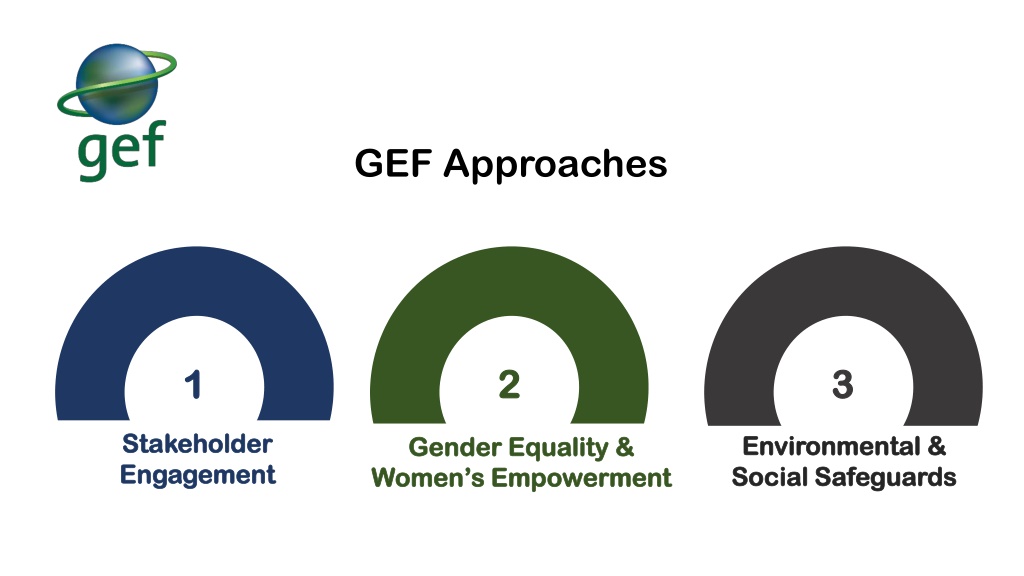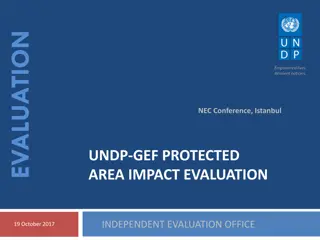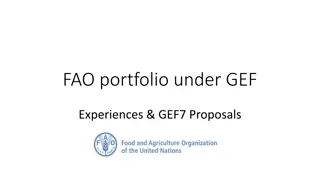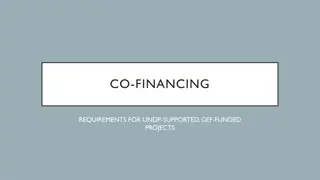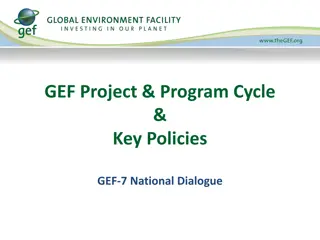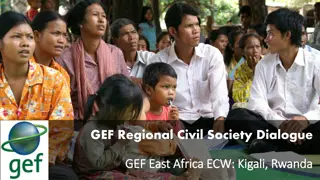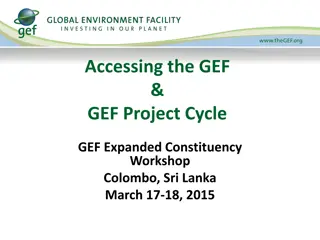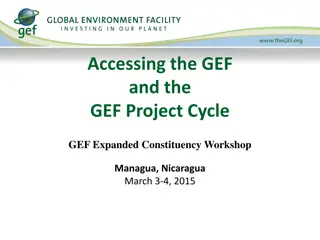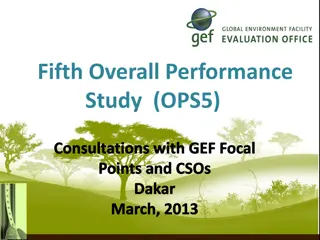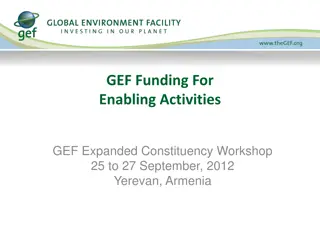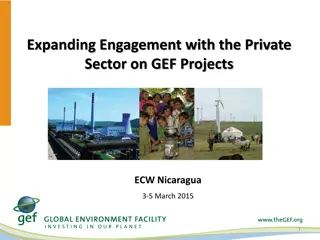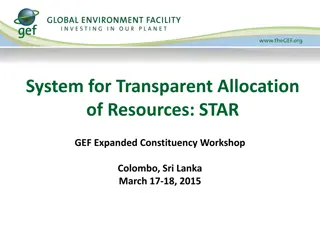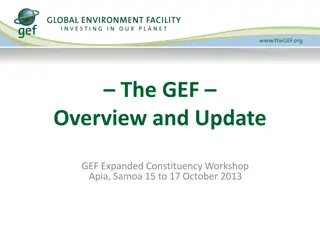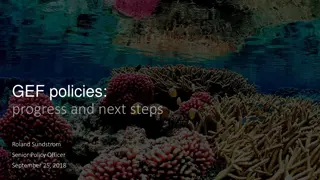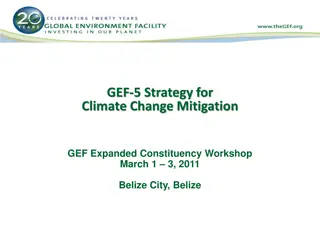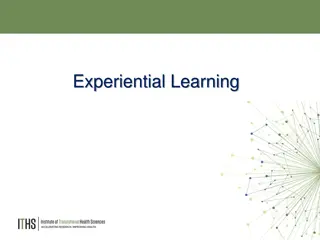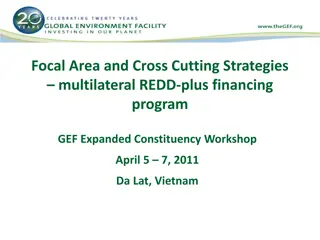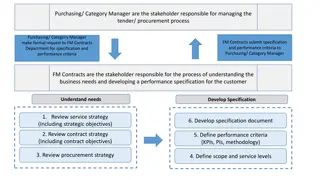GEF Approach to Stakeholder Engagement
GEF's evolving approach to stakeholder engagement emphasizes full disclosure, consultation, and participation of major groups and local communities throughout project cycles. Policies and guidelines focus on promoting inclusive and meaningful stakeholder participation in support of the global environment. Key documents include the 2017 policy on stakeholder engagement, 2014 guidelines, and the 1996 policy on public involvement.
Download Presentation

Please find below an Image/Link to download the presentation.
The content on the website is provided AS IS for your information and personal use only. It may not be sold, licensed, or shared on other websites without obtaining consent from the author. Download presentation by click this link. If you encounter any issues during the download, it is possible that the publisher has removed the file from their server.
E N D
Presentation Transcript
GEF Approaches 1 1 2 2 3 3 Stakeholder Stakeholder Engagement Engagement Environmental & Environmental & Social Safeguards Social Safeguards Gender Equality & Gender Equality & Women s Empowerment Women s Empowerment
1. Stakeholder Engagement Stakeholder Engagement
GEF s Approach to Stakeholder Engagement GEF s operational policies shall provide for full disclosure of all non-confidential information, and consultation with, and participation as appropriate of, major groups and local communities, throughout the project cycle. (Paragraph 5 of GEF Instrument)
GEFs Evolving approach to Stakeholder Engagement 2017 Policy on stakeholder engagement: minimum requirements for agencies to engage stakeholders and clear responsibilities for GEF Secretariat 2014 Guidelines: Practical steps to implement the principles of the 1996 Policy 1996 Policy on public involvement: effective public involvement is critical to the success of GEF- financed projects , and improves project performance and impact. 1994 Provide for full disclosure of all non-confidential information, and consultation with, and participation as appropriate
Process for an Updated Policy on Stakeholder Engagement Nov 2017 1994 2015 - 2017 1996 2014 2017 GEF Instrument Working Group on Public Involvement Policy on Public Involvement CSO Network review of policy Internal and External Consultations Website (public) Policy on Stakeholder Engagement (Full disclosure, consultation and participation) Review draft policy and Consultations (Public Involvement is crucial to success of GEF Projects) GEF Guidelines
Updated Policy on Stakeholder Engagement Objective Promote the inclusive and meaningful participation of Stakeholders in GEF s governance and operations in support of the GEF s mandate to protect the global environment. https://www.thegef.org/sites/default/files/publications/GEFPolicySeries_StakeholderEngagement_r4.pdf
GEFs Policy on Stakeholder Engagement Core Principles Constructive, responsive, accountable and transparent Fair, balanced, and inclusive participation It applies to all GEF-financed activities Sustained commitment and action, including allocation of resources Supported by appropriate documentation and easy and timely access to information
Overview of Policy Requirements Project and Program Cycle Requirements CEO Endorsement Reporting PIF & PFD Description of any consultations conducted during project development* Provide Stakeholder Engagement Plans * or equivalent documentation Include information in PIRs, MTRs, TEs on progress, challenges and outcomes of the implementation of stakeholder engagement Information on how Stakeholders will be engaged and means of engagement throughout the project cycle * Stakeholder Engagement Plan Stakeholders who have been and will be engaged means of engagement dissemination of information roles and responsibilities resource requirements timing of engagement * (preparation of the PIF)
Overview of GEF Secretariats Responsibilities Review & Monitoring Report annually to the Council on stakeholder engagement across GEF-financed activities Assesswhether adequate measures have been proposed to ensure effective stakeholder engagement Update and maintain project and program templates Secretariat-led Activities Engage with stakeholders in a transparent and inclusive manner aimed at fair representation Provide for appropriate stakeholder engagement in the development of GEF policies, guidelines and strategy
Guidelines for the Implementation of the Policy Guidelinesprovide guidance and information on how to implement the Policy, including best practices and useful tools that can be used to conduct meaningful stakeholder engagement throughout the GEF program and project cycles. https://www.thegef.org/sites/default/files/council-meeting- documents/EN_GEF.C.55_Inf.08_Guidelines_Stakeholder_Engagement.pdf
Stakeholder Engagement Stakeholder Engagement for further information please contact for further information please contact Pilar Barrera Senior Operations Officer, Partnerships Partnerships Coordinator pbarrera@thegef.org
2. Gender Equality and Gender Equality and Women s Empowerment Women s Empowerment
Gender and the Environment Gender and the Environment Globally, 43% of agricultural laborers are women, but only 20 20% % of land has female ownership 43% Compared to men, women are more absent in decision making Source: FAO, 2015 Unequal access to land have less access to and control over land and natural resources EQUAL LAND RIGHTS: The law guarantees the same rights to own, use and control land to both women and men. 37 % UNEQUAL LAND RIGHTS: The law does not guarantee the same rights to own, use and control land to women and men, or women have no legal rights to own, use and control land. 4 % have less access to markets, financing and credit LEGAL LAND RIGHTS ARE NOT FOLLOWED IN PRACTICE: The law guarantees the same rights to own, use and control land to women and men, but there are some customary, traditional or religious practices that discriminate against women. 59 %
GEFs Evolving Approach on Gender GEF s Evolving Approach on Gender Moving from a do no harm to a do good gender responsive approach Moving from a do no harm to a do good gender responsive approach GEF Policy on Gender GEF Policy on Gender Equality Equality GEF Policy on Gender GEF Policy on Gender Mainstreaming Mainstreaming GEF Gender Action GEF Gender Action Plan Plan 2012 2014 2017 The GEF Gender Partnership The GEF Gender Partnership Gender Implementation Gender Implementation Strategy Strategy Improvements in project Improvements in project design design Guidance on addressing Guidance on addressing gender in GEF Projects gender in GEF Projects and programs and programs Focus on analyses and Focus on analyses and learning learning
GEFs Policy on Gender Equality GEF s Policy on Gender Equality Respondsto the increased attention to gender equality and women s empowerment by the multilateral environmental agreements (MEAs) that the GEF serves Recognizesthat efforts to combat environmental degradation and those to address gender inequality can be mutually supportive Aimsto catalyze projects that have the potential to materialize greater environmental impact through gender-responsive approaches and results Seeksto ensure equal opportunities for women and men to participate in, contribute to and benefit from GEF-Financed Activities Outlines clear GEF project and program cycle requirements
GEFs Strategy on Gender Equality GEF s Strategy on Gender Equality to generate greater Address gender gaps through strategic entry points Access to and control of natural resources Support women s improved access, use, and control of natural resources Enhance women s participation and role in natural resources decision-making processes, with women as agents of change Global Environment Benefits Environmental decision- making and leadership Target women as specific beneficiaries, and invest in women s skills and capacity Access to socioeconomic benefits and services
Gender-responsive project identification and development Project Identification and Development Project Implementation and Monitoring Terminal Evaluations Mid-term Reviews Project CEO Endorsement Submission PIF/PFD Submission Implementation Reports PPG Carry out an gender analysis Evaluate and report on completed activities and results Report on progress on gender responsive measures, indicators, and intermediate results Report on progress on gender responsive measures Collect information on gender issues relevant to the project context Identify gender-responsive actions Carry out gender-responsive stakeholder consultations Define gender-sensitive indicators Capture and share lessons learned and best practices Learning and adaptation Gender tagging: indicating expected gender result areas Learning and adaptation
Additional Resources Additional Resources Open online Course on Gender and Environment Do you want to find out why promoting gender equality and women s empowerment can help deliver better environmental outcome, and to figure out how you can do it? The course will give you facts and figures and the knowledge and tools to mainstream gender, and to be an effective change-maker for sustainable development. It is a one-stop-shop for information on gender dimensions linked to biodiversity, climate change, land degradation, international waters, and chemicals and waste. https://www.thegef.org/sites/default/files/public ations/GEF%20Guidance%20on%20Gender.pdf https://www.uncclearn.org/course-gender-and-environment
Gender Equality Gender Equality for further information please contact: for further information please contact: Gabriella Richardson Temm GEF Senior Specialist and Lead on Gender and Social Issues grichardsontemm@thegef.org
3. Environmental and Social Safeguards Environmental and Social Safeguards
The GEF was established to support the protection of the global environment and promote thereby environmentally sound and sustainable economic development [providing for] consultation with, and participation [of] major groups and local communities In line with the Instrument, the Policy on Environmental and Social Safeguards aims to: ensure that GEF projects and ensure that GEF projects and programs systematically identify programs systematically identify and address any environmental and address any environmental and social risks and potential and social risks and potential impacts impacts (Instrument for the Establishment of the Restructured Global Environment Facility)
2010 2015 2017 2011 2018 Approach paper Stocktaking/gap assessment Consultations on draft policy Agencies in compliance with GEF ESS standards evolution of the policy
the GEFs approach at a glance projects and programs portfolio monitoring and reporting agency minimum standards GEF Conflict Resolution Commissioner
minimum standards for GEF Agencies 1: 1: Environmental and Social Assessment, Management and Monitoring Environmental and Social Assessment, Management and Monitoring Minimum Standards Minimum Standards 2: 2: Accountability, Grievance and Conflict Resolution Accountability, Grievance and Conflict Resolution 3: 3: Biodiversity Conservation and the Sustainable Management of Living Natural Resources Biodiversity Conservation and the Sustainable Management of Living Natural Resources 4: 4: Restrictions on Land Use and Involuntary Resettlement Restrictions on Land Use and Involuntary Resettlement 5: 5: Indigenous Peoples Indigenous Peoples 6: 6: Cultural Heritage Cultural Heritage 7: 7: Resource Efficiency and Pollution Prevention Resource Efficiency and Pollution Prevention 8: 8: Labor Labor and Working Conditions and Working Conditions 9: 9: Community Health, Safety and Security Community Health, Safety and Security
E&S safeguards in the project cycle CEO Endorsement/ Approval information on the implementation of relevant environmental and social management measures at project mid- term, if applicable, and at project completion indicative information on E&S risks and potential impacts; and any measures to address such risks and impacts additional information on E&S risks and impacts, and measures to address these, including any environmental and social assessments carried out, and any Environmental and Social Management Plans or the equivalent PIF/PFD post-approval + annual reporting by Agencies on cases reported to their accountability, grievance and conflict resolution mechanisms in connection with GEF projects or programs
next steps guidelines for documentation, monitoring and reporting; compliance assessment assessment of Agency compliance capture of data and information through GEF Portal sharing knowledge
references Policy on Environmental and Social Policy on Environmental and Social Safeguards Safeguards http://www.thegef.org/sites/default/files/council-meeting- documents/EN_GEF.C.55.07.Rev_.01_ES_Safeguards.pdf Environmental and Social Safeguards Environmental and Social Safeguards for further information please contact: for further information please contact: Roland Sundstrom Senior Policy Officer, GEF Secretariat ksundstrom@thegef.org
